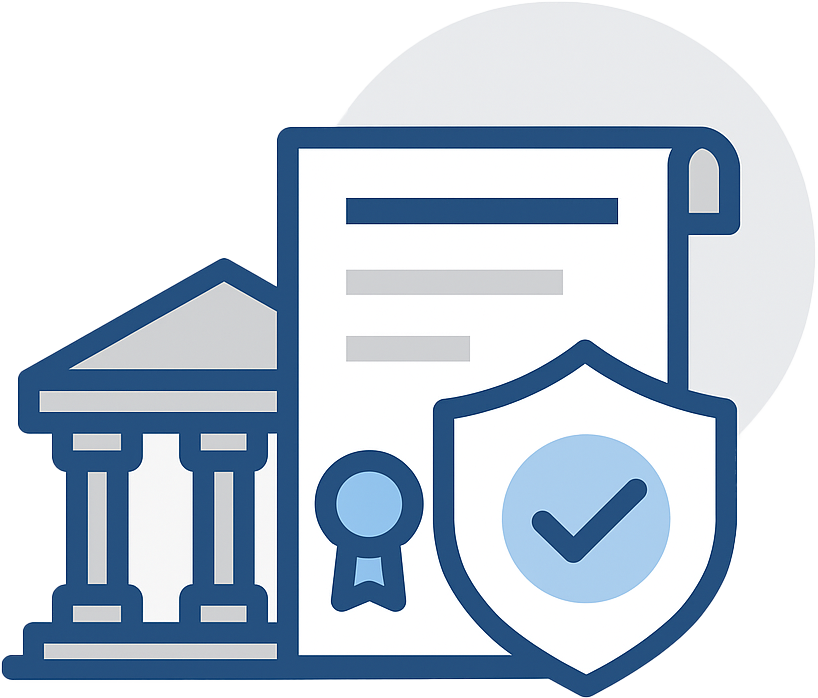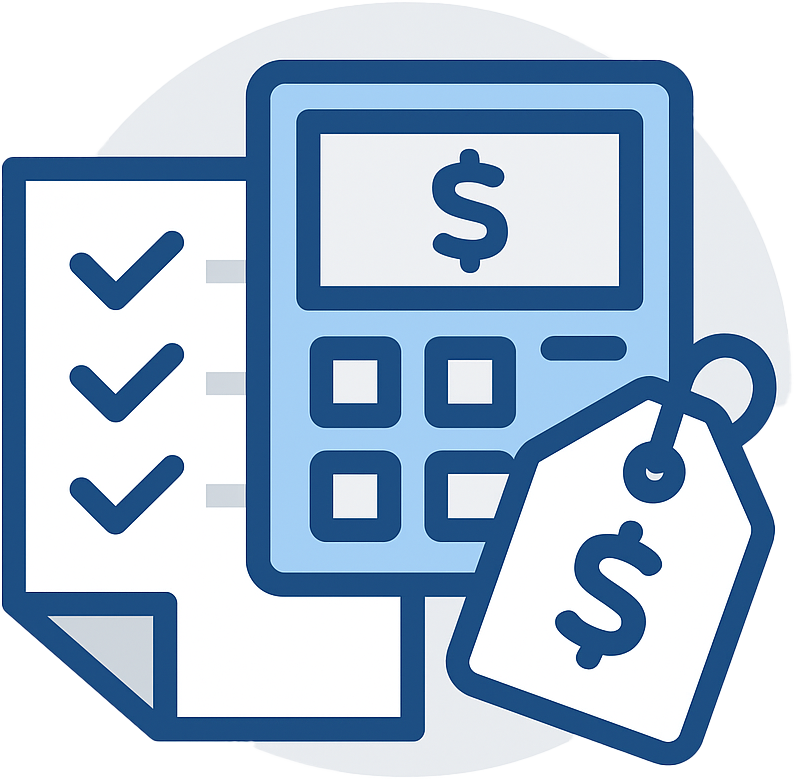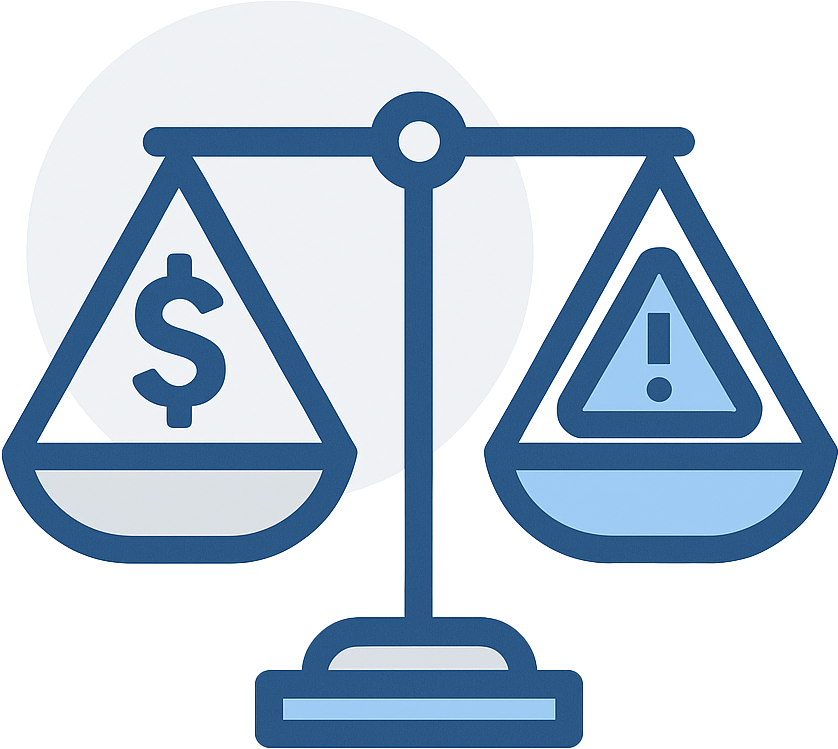Environmental Audits, Explained: What They Are, What They Find, Costs, Timelines, and More!
Not sure where to start with your environmental responsibilities? Feel like you’re probably missing something but don’t even know what questions to ask?
Maybe you’ve got a gut feeling your business isn’t following every regulation, but you’re not totally sure what applies. Maybe you inherited a site or a position in your company, and you're thinking, “What’s actually going on here?”
Or maybe you’re just trying to be proactive and not get blindsided by a surprise inspection, fine, or vendor audit.
If any of that sounds familiar, you’re in the right place.
This article will walk you through everything you need to know about environmental audits: what they are, who does them, what they uncover, what they cost, and why they matter.
We’ll also cover what actually happens during an audit, how results are delivered, and what happens next.
By the time you’re done reading, you’ll have a crystal-clear understanding of how environmental audits work, and more importantly, how they can help protect your business and give you peace of mind.
Still have questions or want to talk to a real human? We do this work every day. Reach out to us at RMA. Even if you’re not ready for an audit, we’re happy to help you figure out what makes sense for your situation.
Table of Contents
Our Environmental Audit Resume
So… who are we to tell you about environmental audits?
We’ve been doing them since 1992, and at this point, we’ve done more than we can count. From sprawling industrial facilities to small-town auto shops, from steaming chemical plants to cutting-edge, squeaky-clean data centers... we’ve seen just about every kind of operation you can imagine.
This isn’t something we read about in a textbook. Our consultants are out in the field every week, boots on the ground, doing this work firsthand. We’re walking sites, reviewing permits, digging through old binders, asking tough questions, and putting together reports that actually help our clients move forward.
In short: environmental audits are what we do. We know what to look for. We know what really matters. And we know how to explain our results in plain English, without turning it into a compliance lecture. If it’s been done wrong, we’ve probably seen it (more than once). And if it’s been fixed, we’ve probably helped make it happen.

What Is an Environmental Audit?
Let’s start at the beginning.
An environmental audit is a review of your company's compliance to environmental regulations, ranging from a basic overview to a deep, comprehensive analysis. An audit could focus on a specific compliance area, such as your NDPES permit and its associated requirements, or it may serve as a broader assessment to verify environmental compliance without delving into intricate details.
Basically, it's a checkup to see how you’re doing when it comes to following the rules. It’s about finding out what applies to you, what you’re doing well, and what might be missing or at risk of causing problems down the road.
Think of it like a routine visit to the doctor. You might feel fine, but a checkup can catch issues early - before they become painful, expensive, or a real liability. Same goes here. An audit helps you spot blind spots and fix them before an inspector (or someone else) does.
An audit pulls everything into focus - not in a scary way, but in a way that makes you go, “Oh, okay, now I get it.” You see what’s working, what’s missing, and what actually matters. It takes all the guesswork out and gives you a clear idea of what to do next, so you’re not left wondering if you’re flying under the radar or heading for trouble.
Whether you’re brand new to environmental compliance, trying to clean up inherited messes, or just want to be sure you're on the right track, an audit is a smart place to start. And hey, if you're not ready to fully jump in – check out our free online environmental assessment tool here. It's the best we can do without a full on-site evaluation!

The Biggest Misconception: Who Conducts an Audit?
This is the number one thing people get wrong about environmental audits.
You hear the word "audit" and immediately think of the IRS showing up because you didn’t file something right. You imagine someone flipping through your paperwork, pointing out problems, and leaving you with a huge fine. That kind of audit feels scary!
But that is not what an environmental audit is.
Environmental Consultants Generally Conduct Environmental Audits, Not the Government
When we talk about environmental audits, we’re talking about something completely different. This isn’t something that’s forced on you. It’s something your company chooses to do because you want to know where you stand.
Environmental audits are done by environmental consultants (like us!), not regulators. You hire us, and we come in as a partner, not a punishment. We’re there to help you figure out what applies to your business, what you’re doing well, and what still needs to be addressed.
There’s no clipboard-wielding inspector trying to catch you doing something wrong. There’s no fine at the end. This isn’t about reporting you or getting you in trouble. It’s a tool to help your business improve, get ahead of issues, and reduce risk.
So when we talk about environmental audits in this article, we’re talking about the kind that you want – the kind that helps you take control of your compliance and move forward with confidence.
The Government Does NOT Conduct Environmental Audits… But They Do Conduct Inspections – Here’s the Difference
When we talk about environmental audits, we’re not talking about someone from the EPA or your state agency showing up to dig through your paperwork and hand you a fine.
Government agencies don’t conduct audits, at least not in the way you're thinking the IRS would "audit" you. What they do is conduct inspections, and while those might sound similar, they’re really not.
An audit looks at the big picture. It’s a wide-angle review of your entire environmental program or a specific area with the goal to improve. A government inspection? That’s usually narrow, laser-focused on just one specific thing, and it's basically pass/fail. A pass is to resume business as normal, and a fail is to get in trouble. And different agencies (even different people within the same agency) often handle completely separate regulations.
For example, you might get a visit from someone focused on stormwater who notices you don’t have a permit and writes you up. But that inspector probably doesn’t know the first thing about oil storage rules and won’t check if you're doing your Tier II Reporting every year. Then a month later, someone else from a different government agency shows up and fines you for that. Lovely.
The truth is, you’re probably never going to have a government inspector show up and give you a full picture of your environmental situation. In our decades of experience, they just don't do that. We often hear people ask if someone from the township will come out and tell them everything they need to do. That's like asking if your local tax assessor will be able to answer your questions on your Federal tax returns. It goes the other way as well, an IRS agent will be of zero help when it comes to your local property tax concerns.
This is why audits from a consultant are so valuable - because they CAN tell you everything. They can give you the complete view in one shot (from someone who wants to help), not just one piece of the puzzle (from someone who wants to catch you and fine you).

Other Types of Environmental Audits
Now, to be fair, not every environmental audit comes from a friendly consultant who’s looking out for your best interests.
There are a few types of audits you might encounter, and honestly, they’re not always as helpful or collaborative. In fact, some of them can catch you off guard, create tension, or even put business relationships at risk.
Let’s break down the three most common types of environmental audits that aren’t from a consultant, and why they’re usually not ideal.
Audits from Your Internal Team
You might be thinking, “We’ve got an environmental guy... can’t he just audit our stuff?”
It’s a fair question. But here’s the issue:
First, if everything was running perfectly under their watch, there probably wouldn’t be a need for an audit in the first place. An internal audit often turns into more of a formality than a real assessment. It’s hard to spot problems from inside the system, especially if you’re the one who built it.
Second, internal teams tend to stay in their lane. Maybe they’ve been keeping up with the requirements you’ve always had, but they might not be tracking newer rules or less obvious regulations that apply now, especially if the business has grown or changed over time.
And third, let’s be honest - most people don’t want to raise their hand and say, “Hey, I’ve been in charge of this, and we’ve actually got some issues. I've done a bad job and we could be in trouble!” That’s a tough position for anyone to be in, even with the best intentions.
That’s why it’s almost always better to bring in an outside consultant. Someone with fresh eyes, current knowledge, and no internal bias. Someone whose job is to help you see the full picture and fix what needs fixing, not to defend past decisions.

Audits from Customers, Suppliers, and Vendors
These days, more and more companies want to work with partners who take environmental responsibility seriously. That’s especially true in the world of large corporations and complex supply chains.
Smaller shops might never run into this. For example, if you’re a local maintenance garage, your customers probably aren’t asking about your stormwater plan or requesting copies of your Tier II Reports. But if you’re running a shop that services a major customer, it could be a different story entirely.
Think of big players, giants like Google and Amazon, hospitals, colleges, even progressive local governments here in the US, won’t just take your word for it. They want to know you’re operating responsibly, and sometimes that means sending in their own team to take a look. These are audits with real consequences. A poor result can be the reason you lose a contract, or never get one in the first place.
Unlike a consultant who’s there to help you improve, customer or vendor audits usually aren’t designed to be collaborative. They’re trying to protect their own brand, and if you don’t meet their standards, that might be the end of the relationship.
Audits from the Public
Alright, this one’s a little unconventional. You probably wouldn’t call it a formal audit, but the public can absolutely look into your environmental program (more than ever before!), and well, they often do.
Between online databases of your permits (every state has online databases, and the EPA maintains one as well), satellite imagery, drone footage and people exploring and posting YouTube videos, and even just curious neighbors, it’s easier than ever for someone to check out what’s going on at your site. And if something doesn’t look right? They can report it. And they do, a lot.
It's extremely easy to check if you have a stormwater permit, if you are doing Tier II Reporting, TRI Reporting, have an air permit, what your results are, and more and more. The public can "audit" you without ever engaging with you - and that means they can easily figure out if you're a bad actor or not.
This isn’t about paranoia. It’s just the reality of living in a very visible world. Whether it’s an activist, a local resident, or just someone scrolling through Google Earth, people have access to more information than ever before.
If you’re not in compliance, someone out there might notice, and they might not just keep it to themselves!

What Actually Happens During an Environmental Audit?
So, you’ve brought in a consultant to do an environmental audit. What actually happens next?
It starts with getting to know your business. Your consultant will ask a lot of questions – about who you are, what you do, where you operate, and what your main concerns are. They’ll want to understand the full context, because environmental regulations vary widely depending on your location, your industry, and even your specific processes. But this is just the beginning!
The real work begins with the site visit. Your consultant will come out in person and walk your facility. This isn’t a quick glance. They’ll be looking closely at your operations: where materials are stored, how equipment is used, where runoff might occur, and what systems are in place to manage risk. If you store oil, they’ll check tank capacities, secondary containment, and spill records to see if you need an SPCC plan. If you store materials outdoors, they’ll consider how stormwater rules apply. If you use certain types of machinery, they might flag air permitting issues. Everything gets looked at through the lens of current, applicable regulations.
They’ll also review whatever documentation you already have. That could include permits, inspection records, compliance reports, site maps, spill response plans, training logs, violation notices, and anything else that might affect your regulatory picture.
They'll also dig into online databases such as the USEPA's Echo Database, or state level parallels. Again, your information is out there and usually pretty easy to find.
And this is where the job could get technical. A deep-dive, thorough audit often involves performing calculations, like checking threshold quantities for hazardous materials to assess your generator status, or calculating containment volume for SPCC compliance. It might mean taking a full inventory of your materials, then figuring out what's actually in those materials, and then comparing them to thresholds for Tier II or TRI reporting. It might involve cross-referencing multiple layers of regulation (federal, state, and sometimes even local) to see what applies and where there are gaps. No two sites are the same, and it takes real experience to know what to check, what to measure, and what to ask.
Once everything’s been seen and reviewed, the consultant will take time to process it all. They’ll connect the dots and build a complete picture of where you stand, and from there, they’ll prepare to share what they found.

How Do I Get My Environmental Audit Results?
This part can feel a little sensitive, and for good reason. In many cases, audit results are delivered in the form of a written report. That sounds helpful, and often it is... but... once something is in writing, it can take on a life of its own. And that’s where things can get tricky.
Let’s say we give you a report that outlines a few serious issues - things that clearly need to be fixed. But then the report gets shoved in your "environmental drawer" and forgotten. A year later, a government inspector shows up, starts flipping through your paperwork, and finds it. Suddenly, you’re not just out of compliance because you had no idea... you’re knowingly out of compliance. And that’s a much bigger problem. As in hire a lawyer you could be in a lot of trouble bigger problem.
Written reports can also get passed around more than you’d expect. Emails get forwarded. Thumb drives get misplaced. Shared folders get accessed. You never know where a file might end up, or who might come across it. And the last thing you want is your environmental challenges becoming someone else’s business.
Because of that, a lot of companies prefer to handle audit results differently.
Instead of sending a full written report, many consultants (including us) might walk you through the findings in a private, face-to-face (or virtual) meeting. We’ll talk through what was observed, what it likely means, and what next steps should be considered. That way, you get the clarity and direction you need, without the risk of a paper trail that could come back to bite you.
And some companies take it a step further. They choose to have their attorney receive the findings from the consultant instead, so that when they relay it to you, your conversation is protected under attorney–client privilege. This adds an extra layer of privacy, especially if you’re concerned about what might be uncovered.
And if you decide not to act on what was shared? At least there’s no formal document floating around that says you knew and didn’t do anything. At the end of the day, the goal is to help you improve - but how that information is shared should be done in a way that protects you, not exposes you.

Will I Get in Trouble if Something Is Found to Be Wrong?
This is one of the most common questions we hear, and it makes total sense. If you’re worried something might be out of compliance, it’s natural to wonder if bringing in a consultant is just going to make things worse.
The short answer? No, you’re not going to get in trouble. Not for having something wrong. Not for asking for help. Not for getting an audit. At least not if you hire us.
If you’re like the vast majority of businesses – even if you are out of compliance – nothing bad is going to happen just because a consultant found an issue. You’re hiring someone to help you. They’re on your side. We’re not the EPA. We’re not here to fine you, report you, or shame you. We’re here to give you clarity and help you fix things.
Okay, so what was all that about written reports and attorney-client privilege above, then? Well... let’s talk about the very rare exceptions.
In a tiny percentage of cases, if something truly serious is found (like hazardous waste being disposed of illegally) your consultant might recommend that you self-report to the proper agency. That doesn’t mean they’re throwing you under the bus. Quite the opposite. Self-reporting is seen as a responsible move, and agencies are generally much more cooperative and lenient with businesses that come forward on their own. But again, this is only for major issues, and something that absolutely has to be discussed with legal counsel.
And there’s an even rarer scenario, where a consultant might be legally required to report something. That only happens when there’s an immediate and active threat – something truly major like toxic chemicals leaking into a public water supply. Or maybe the consultant has some type of accreditation or certification with the state agency that requires reporting, no matter what. Regardless, if that's the case, then they should be communicating that to you well in advance. In our experience, we’ve never had to report anyone. And we've seen a lot!
So if you’re worried that an audit will open the door to trouble, you can let that fear go. Every audit we can remember working on spanning back over 30 years has been handled privately, constructively, and with the clear goal of helping the client improve – not getting them in trouble!
Read more about our confidentiality standards and what we won't report you for here.
How Long Do Environmental Audits Take?
The short answer? It depends.
If you’re getting an audit from an environmental professional, the timeline is going to be shaped by two main factors: how complex your situation is and how quickly the consultant can get to you.
If your site is fairly simple - minimal paperwork, no major environmental headaches, everyone’s available to move things along, and your consultant is down the street - the whole process could be wrapped up in just a few days. That’s rare, but it happens.
On the other hand, if you’ve got a sprawling manufacturing facility, documents dating back to the 1960s, and a consultant trying to fit a flight across the country to you in between other major deadlines like Tier II season, the process might take a few months.
Here at RMA, most audits we conduct are completed in about a month or less from the initial conversation to the final delivery of results. Some are quicker, some take a little longer, but that’s a good ballpark for what most clients can expect.
If you’re facing a specific deadline or need things done on a rush basis, just let us know. We’ll always be upfront about what’s realistic and work with you to make it happen.

How Much Do Environmental Audits Cost?
Just like timeline, the cost of an environmental audit really depends, mainly on the complexity of your site and how quickly you need the results.
If you’re running a small metal fabrication facility, and have limited environmental compliance requirements, your audit might cost around $1,000. But if you're a chemical manufacturer with a sprawling facility, a tight timeline, and a whole stack of historical documents to dig through, that number could be closer to $25,000 or more.
Easiest way to find out? Use the free tool below to get a sense of your cost range instantly!
Most audits we do here at RMA fall somewhere in the $3,000 to $7,500 range. That’s the average for a typical facility with a moderate level of complexity, no urgent time crunch, and a cooperative site team. But those numbers can move depending on what we’re walking into.
We’re always upfront about our pricing. If you’re wondering what it might cost for your specific situation, just reach out or submit your email on the final screen of the tool above. We’re happy to talk it through with you. No pressure, no sales pitch. Just a real conversation about what you need and what it might take to get it done right.

What Do Environmental Audits Usually Find?
Well… this is a loaded question.
Findings can run the full range from “looks all good!” to “if the EPA walked in tomorrow, you could be staring down criminal charges.” Most audits fall somewhere in the middle. But one thing’s for sure: there’s almost always something that needs attention.
Here are some of the most common issues we uncover:
- Core compliance items totally missing. These are the big ones. No stormwater permit when one’s clearly required. No air permit for equipment that triggers it. Completely unaware that Tier II or TRI reporting applies to your operation. That kind of thing.
- Neglected or outdated compliance info. You’re registered as a Small Quantity Generator of hazardous waste, but your operations have grown and now you’re a Large Quantity Generator, and nobody caught it. Or your permits haven’t been updated in years, even though your processes have changed.
- Nuanced local or state-level requirements. You have an SPCC Plan, but had no idea Louisiana also requires an SPC Plan, did you (yes that's actually true, you're welcome). You’ve done the big stuff, but didn’t realize there are additional rules at the local level. This happens all the time, especially with stormwater, hazardous materials storage, spill prevention, or local air quality districts.
- Untrained staff. You might know what an SPCC plan is, but if your employees don’t because they haven't had annual training (and they’re the ones who could cause or would clean up a spill) you’re still not in compliance. Many environmental regulations require regular, effective, documented training, and we often find that it’s either missing or incomplete.
- Poor documentation. This one’s common. Permits and plans are stuffed in a binder on a dusty shelf, inspection logs are missing, and nothing’s organized. If someone asked to see proof you’re in compliance, it’d be hard to produce on the spot.
The bottom line? If you’re even thinking about whether you might need an audit, that’s probably your sign. Most companies have a hunch that something’s missing, they just haven’t had the chance (or the time) to look closely. That’s exactly what the audit is for. And if something’s missing, we’ll find it.
To get a snapshot of some possible audit results in just a couple minutes, check out our free online environmental assessment tool!

Let’s Take a Pause: Sticker Shock and Regulatory Whiplash
Let's talk turkey for a second. If you’ve read through the last two sections and you’re feeling a little anxious, you’re not alone. For a lot of people, this is the moment where things start to feel heavy. Maybe the costs are higher than expected. Maybe the list of possible problems feels longer than you thought. And maybe you’re wondering what you’ve gotten yourself into.
We have a name for that feeling. Actually, two.
We call it sticker shock and regulatory whiplash. It’s that moment where you start to realize this whole environmental compliance thing might be more complicated, more expensive, and more serious than you were prepared for.
And yes, it’s real. We hear it all the time. Check out the video below where we break this down a bit more. It’s short, honest, and will help you make sense of what you’re feeling.
So, if you’re feeling that way at all, just know you’re not alone. We get it. This stuff is confusing, it can be pricy, and yeah, you might just wish you could hide from it altogether. Check out the next section to learn why we think that’s a BAD idea.
Is an Environmental Audit Worth It?
Well, you’d be asking environmental consultants, the people who get paid to do this, if it’s worth it. Shocking answer here: yes, we think so. But it’s not just because we’re biased, it’s because we know what’s at stake.
Environmental fines can be, well, crippling. Maximum fines can reach over $100,000 (no that's not a typo) – and that’s per-violation, per-day. If the government really wanted to throw the book at you for doing something wrong, you could be looking at an astronomical fine. Just two violations left unresolved for a week could stack up to a million dollars in penalties. And that’s before you factor in legal fees, reputational damage, or lost business opportunities. In short: the cost of non-compliance is more than just fines.
We’ve seen what happens when companies don’t get ahead of this stuff. We’ve seen the fines, the shutdowns, the legal messes, and the stress that could have been avoided with a little foresight. It’s always better to bite the bullet up front rather than paying the price down the line.

What Happens After an Environmental Audit?
Well, if your consultant finds nothing, you’re free to go about business as usual. Nice work! Of course, most audits don’t end that way. There’s usually something that needs fixing. So... now what?
A good consultant won’t just hand you a report card and disappear. They’ll become your tutor - someone who sticks around to help you get things in order. That means giving you a clear, honest roadmap. What needs to be done now, what can wait, what’s worth thinking about, and what your next steps should be.
And if that list feels overwhelming (or if you’d rather not take it on alone) they can often help you tackle that work directly by doing the heavy lifting for you. If they point out you need an SPCC Plan, they should be able to then, for an additional service and fee, be able to develop that plan for you.
At RMA, that’s exactly what we do (if you want us to). We’re not here to pressure you, but we’re always ready to jump in. Need help applying for permits? Want someone to look over your Tier II reports before you hit submit? Hoping to turn your entire program around and become a leader in your industry? We’ve helped clients do all of that after audits, and we’re happy to help you, too.

Wrapping Up: How to Get an Environmental Audit
If you’ve made it this far, first of all, thank you. Environmental audits aren’t exactly light reading, but if you’re here, it means you care about getting this right. That already puts you ahead of the game. And if you’re thinking, “Okay… maybe I do need an audit,” we’d love to be part of that conversation.
We’ve been doing environmental audits since 1992, and over the years, we’ve worked with just about every kind of business you can imagine: manufacturers, warehouses, auto shops, concrete plants, office buildings, schools, data centers, and everything in between. We’ve seen the messy, the confusing, the totally overlooked. And we’ve helped a lot of operations get back on track.
Our approach is pretty simple. We try to make this process as easy to understand as possible. We don’t talk down to people, we don’t make anyone feel bad, and we don’t leave you with a pile of problems and no path forward. We’re here to help you figure out what’s going on, what matters most, and what to do next.
So whether you’re ready to schedule something, want a rough quote, or just need to pick someone’s brain for 15 minutes, reach out. Seriously. Even if it’s just to get a gut check or ask, “Do we even need this?” – we’re happy to talk.
No pressure. No pitch. Just honest help, from people who do this every day.






















